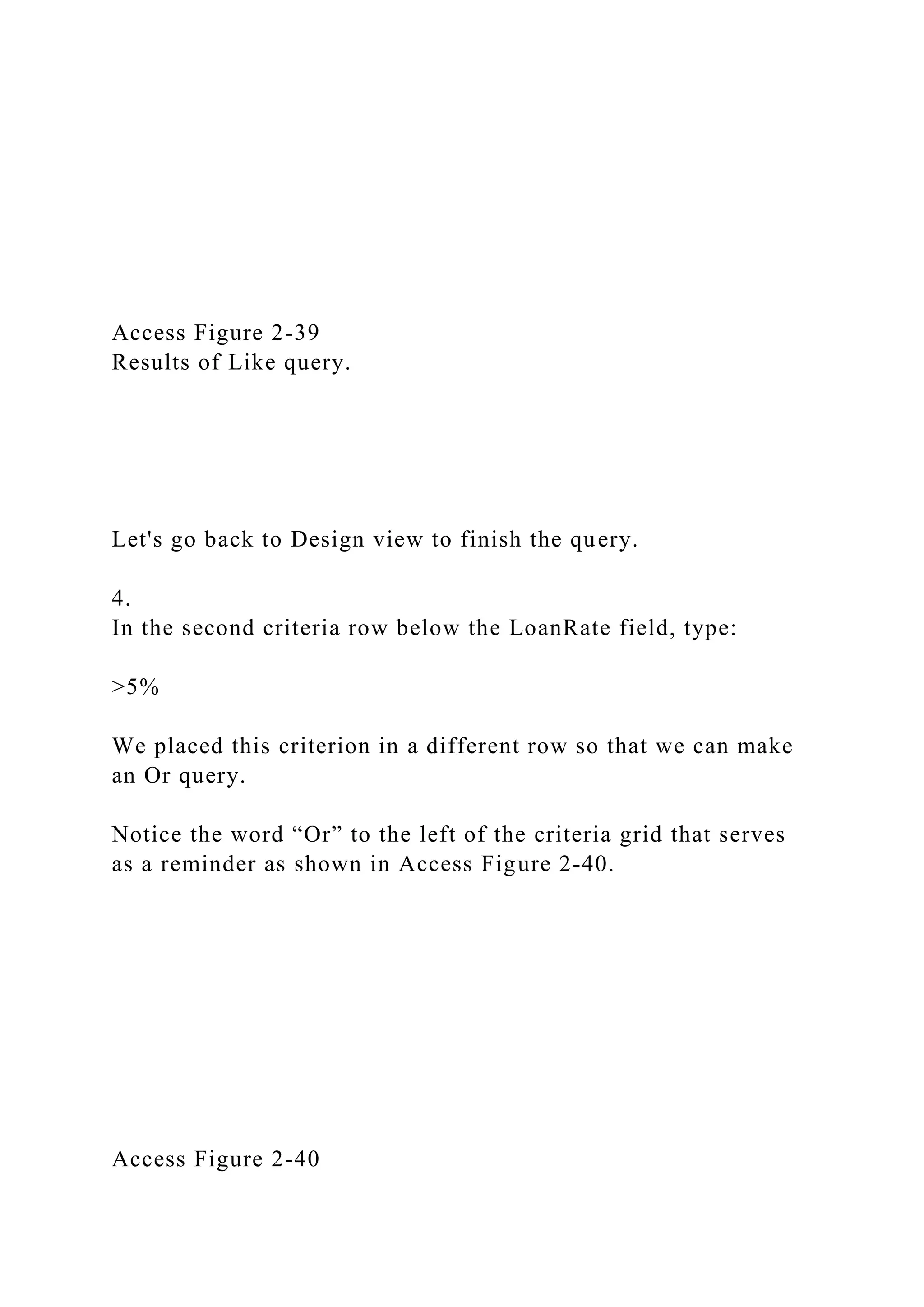This document provides an introductory tutorial on Microsoft Access 2007, a relational database application within the Microsoft Office suite. It covers essential features such as creating databases and tables, understanding the relational model, and utilizing various components of the Access interface to organize and manage data effectively. The tutorial also outlines practical steps for creating a sample database focused on banking loans, including defining fields and setting properties.































































































































































![You are now ready to enter data into the customers and
customerLoans tables. Sample data for you to use is shown in
Access Tables 3-3 and 3-4. You can add data directly using the
Datasheet view, or better yet, create a couple of form objects
and use them.
Access Table 3-3
customers data
custID
custLastName
custFirstName
custBirthDate
custEMail
765-56-6765
Rockefeller
Horatio
12/12/1958
[email protected]
789-76-5432
Carnegie
James
4/27/1963
[email protected]
812-81-0028
Trump
Daffy
3/21/1954
[email protected]
999-11-1111
Patrick
Chris
04/27/1973
[email protected]
999-22-2222](https://image.slidesharecdn.com/accessassignmentscompletelist1-221115003346-9c4307e1/75/Access-Assignments-Complete-List1-Acc-2-Bank-Database2-Acc-docx-160-2048.jpg)
![Mullins
Jesse
07/24/1985
[email protected]
999-33-3333
Crider
Russ
08/22/1974
[email protected]
999-44-4444
Goodly
Alice
01/31/1962
[email protected]
999-55-5555
Roberts
John
03/15/1977
[email protected]
999-66-6666
Carrall
Ann
11/15/1978
[email protected]
999-77-7777
Arons
Suzy
09/07/1944
[email protected]
999-88-8888
Allman
Keegan
06/08/1972
[email protected]
999-99-9999
Hyatt](https://image.slidesharecdn.com/accessassignmentscompletelist1-221115003346-9c4307e1/75/Access-Assignments-Complete-List1-Acc-2-Bank-Database2-Acc-docx-161-2048.jpg)
![Ashley
08/22/1969
[email protected]
Access Table 3-4
customerLoans data
custLoanStart Date
custLoan Amount
custLoan Status
Customer (FKcustID)
Loan (FKloanID)
06/01/2004
$200,000.00
Current
Carnegie
15 Year Mortgage
01/09/2005
$150,000.00
Current
Patrick
15 Year Mortgage
01/15/2005
$14,000.00
Paid in Full
Crider
Auto Loan 48-Month](https://image.slidesharecdn.com/accessassignmentscompletelist1-221115003346-9c4307e1/75/Access-Assignments-Complete-List1-Acc-2-Bank-Database2-Acc-docx-162-2048.jpg)













































































![tblCourse
=
Unique Identifiers (become the primary keys in your tables)
*
Sample Table View of the Employee
EntityEmpIDEmpLNameEmpFName
EmpPhNumEmpEMail1JohnsSara555-
1213[email protected]2MarksJennifer555-
1214[email protected]3TimberlakeIsaac555-
1215[email protected]
Sample Table View of the Course
EntityCourseIDCourseNameCourseType1Intro. to Day
HikingHalf-Day2Basic BackpackingHalf-Day3Rock Climbing
FundamentalsAll-Day4Intro to KayakingAll-Day
Sample Table View of the Customer
EntityCustIDCustLNameCustFNameCustAddressCustCityCustSt
ateCustZipCodeCustEMail1KreggPat123 Main
StreetYourtownCA90200[email protected]2LentenLisa Rose12
College
AvenueAnytownGA30600[email protected]3NicolsEstelle23
Church StreetMytownND73040[email protected]
Sample Table View of the Class
EntityClassIDClassDateClassStartTime
ClassEndTimeClassLocationFKCustIDFKEmpIDFKCourseID11
0/28/200609001200Rocky Bald
State Park
Conference Room222209/16/200609001100In-](https://image.slidesharecdn.com/accessassignmentscompletelist1-221115003346-9c4307e1/75/Access-Assignments-Complete-List1-Acc-2-Bank-Database2-Acc-docx-240-2048.jpg)















![day535WILLISVIVEK28.0Tuesday536WILLISWALTER44.0We
dnesday537WILTROUTWALTER32.0Thursday538WINBORNE
WANG52.0Friday539WINZELERWESLEY56.0Saturday540WO
LFEWILL44.0Sunday541WOODWILL55.0Monday542WOODE
WILLIA54.0Tuesday543WOODERWILLIAM26.0Wednesday54
4WOODHAMWILLA40.0Thursday545WOOLLEYWILLIAM57.
0Friday546WORRALLWILLIAM28.0Saturday547WRIGHTWIL
LIAM60.0Sunday548WYNNWILLIAM21.0Monday549YEOMA
NSWILLIAM42.0Tuesday550YONCHAKWOOKTA24.0Wednes
day551YOUNGXING60.0Thursday552ZBOINSKAYOUNG26.0
Friday553ZEIGLERZANE45.0Saturday
ACC_4_MC_LinkSaver.accdbLIDLTitleLURLNumLinksLinkAd
dDate1Google Search
Enginewww.google.com24/7/072Yahoo!www.yahoo.com24/6/07
4CNN News Networkwww.cnn.com14/3/075University of
Georgiawww.uga.edu14/10/077Official ASP.Net
Sitewww.asp.net24/27/07LUIDfkUIDfkLIDLCatLDate111Searc
h4/7/07212Search4/6/07421Search Engines4/20/07532Search
Sites4/27/07624News4/3/07735School4/10/071127Programming
4/28/071217Web
Development4/27/07UIDLUserNameLPasswordLEmail1cpearso
nsd123$[email protected]2kilgorej$k$L$[email protected]3Aden
ta2b9c2[email protected]4nickdnao89s[email protected]5estelle
98jk12$[email protected]6jimoskd49[email protected]
SELECT tblUserLink.fkUID, tblLink.LID
FROM tblLink INNER JOIN tblUserLink ON
tblLink.LID=tblUserLink.fkLID
WHERE (((tblUserLink.fkUID)=1));
SELECT tblUserLink.LDate, tblLink.LTitle, tblLink.LURL
FROM tblLink INNER JOIN tblUserLink ON
tblLink.LID=tblUserLink.fkLID
WHERE (((tblUserLink.LCat)="Search") AND
((tblUserLink.fkUID)=1));](https://image.slidesharecdn.com/accessassignmentscompletelist1-221115003346-9c4307e1/75/Access-Assignments-Complete-List1-Acc-2-Bank-Database2-Acc-docx-256-2048.jpg)






























